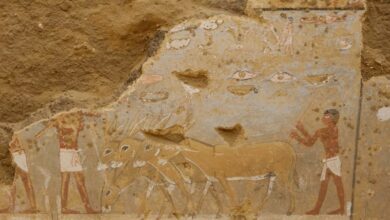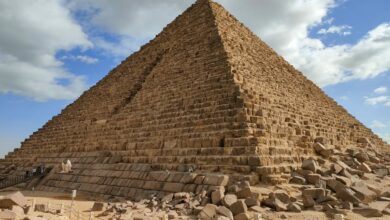The 4,200-year-old burial chamber of Queen Behenu has been discovered in Saqqara in Giza.
French archaeologists digging in the necropolis of Pepi I discovered the tomb with an intact sarcophagus and a set of Pyramid Texts belonging to the queen, who had likely been a second wife of 6th dynasty Pharaoh Pepi II.
"This necropolis was quite an important place; a sacred place, even after the time of Pepi I," said Philippe Collombert, who leads the mission sponsored by the French Ministry of Foreign Affairs. "He was an important king, so probably queens from later times wanted to be buried in the same place."
Archaeologists are not 100-percent certain that the queen was in fact the wife of Pepi II, as her tomb contains no specific references to her husband. Collombert, who is also a professor at the University of Geneva, said it was uncommon during Pepi I’s time to find Pyramid Texts in the tombs of queens.
The first queen known to have been buried with Pyramid Texts is Akhespepi II, a wife of Pepi I and the mother of Pepi II.
"Ankespepi II was the one in charge of the kingdom because Pepi II was just a small child [when he ascended the throne]," Collombert said. "That’s why she probably had some Pyramid Texts."
Pyramid Texts are the earliest known collections of religious writings from ancient Egypt. They detail rituals concerned with the afterlife, particularly as they pertained to the king’s resurrection and destiny among the gods. To date, only 11 tombs have been found with these texts, and no single pyramid has yet been discovered with a complete set. The earliest known Pyramid Texts date to the last king of the 5th Dynasty, Unas, who ruled roughly 100 years before Pepi II.
"Pyramid Texts are the first corpus of writing in the world," Collombert said. "This is the very first huge grouping of text in the history of the world. That’s why it’s so important to find these Pyramid Texts, even if they’re the same as those found in other pyramids. Sometimes one sentence will change and some new words and sentences will appear with formulas for the afterlife."
Collombert said that Queen Behenu’s Pyramid Texts had been found scattered in pieces around her 25-meter-wide pyramid as part of a "big puzzle." The tomb, like many of those found in the area, was in poor condition due to quarrying during the Mamluk period, which ended about 500 years ago.
"They were trying to find fine limestone," he said. "That’s why they took out all the casings of all the pyramids and they also got inside the funerary chamber to dig out all the stones. Most of the time, we just find a big mound of stone."




